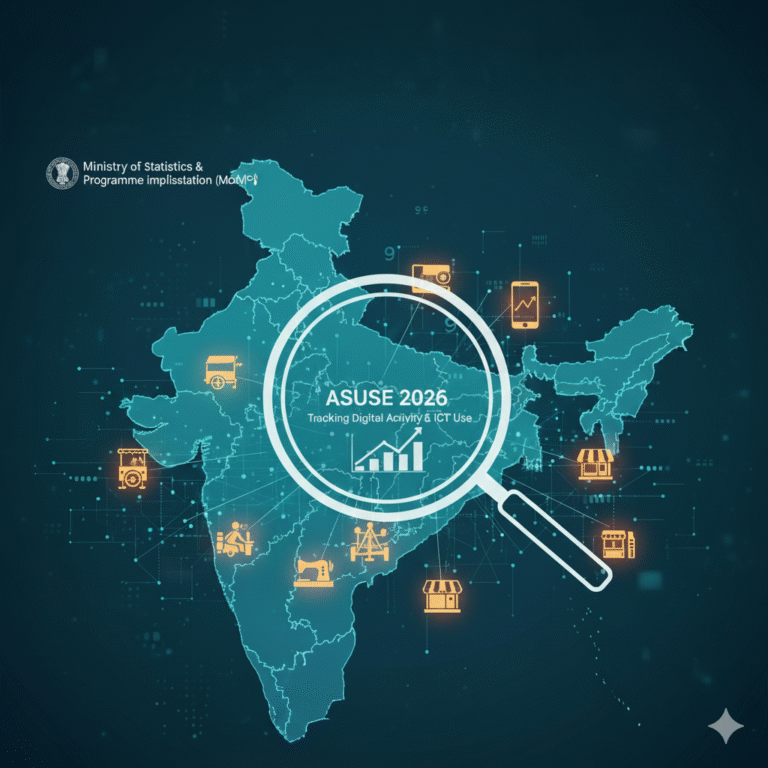Key Highlights
- India’s total exports reached record $820.93 billion in FY 2024-25 with 5.50% growth, comprising $437.42 billion merchandise and $387.50 billion services exports
- Electronics sector leads growth with 12.6% expansion reaching $27.8 billion, driven by PLI scheme success and domestic manufacturing boost
- Trade deficit improved significantly to $94.26 billion with merchandise deficit at $238.3 billion offset by services surplus of $162.06 billion
- Strategic FTA network includes 13 active agreements with UAE CEPA targeting $250 billion bilateral trade by 2030 and Australia ECTA providing comprehensive market access
- PLI scheme across 14 sectors transforming manufacturing with textiles turning from net importer to exporter and smartphones achieving 14% global iPhone production in India
India’s foreign trade landscape is experiencing a transformative phase, with total exports reaching $820.93 billion in FY 2024-25, marking a 5.50% growth and representing a 67% increase from $466.22 billion in 2013-14. This remarkable trajectory encompasses both merchandise exports of $437.42 billion and services exports of $387.50 billion, demonstrating India’s evolving position as a global trade powerhouse with diversified export capabilities. The trade composition reveals a strategic shift from traditional raw material exports toward higher-value manufactured goods including engineering products ($116.67 billion), electronics ($27.8 billion with 12.6% growth), and pharmaceuticals ($30.9 billion with 7.5% growth), supported by game-changing Production Linked Incentive (PLI) schemes across 14 critical sectors and strategic Free Trade Agreements with UAE, Australia, and other key partners. With India’s merchandise trade deficit narrowing to $238.3 billion in FY24 from $264.9 billion in FY23 and a services trade surplus of $162.06 billion, the nation is strategically positioned to achieve its ambitious $2 trillion export target by 2030. India’sExports pib.gov
Recent Trade Performance: Growth Trajectory and Sectoral Dynamics
FY 2024-25 Trade Statistics: Record-Breaking Performance
India’s trade performance in FY 2024-25 has demonstrated remarkable resilience despite global economic uncertainties, with cumulative exports reaching historic heights.
Comprehensive Trade Overview (FY 2024-25):
- Total Exports: $820.93 billion (5.50% growth)
- Merchandise Exports: $437.42 billion
- Services Exports: $387.50 billion (12.45% growth)
- Total Imports: $915.19 billion
- Trade Deficit: $94.26 billion (significant improvement from previous years)
- Current Account Deficit: 0.7% of GDP (reduced from 2% in FY23)
Sectoral Growth Champions: Electronics and Pharmaceuticals Lead
India’s Balance of Payments has shown significant improvement, with the Current Account Deficit narrowing dramatically from $67 billion (2% of GDP) in FY23 to $23.2 billion (0.7% of GDP) in FY24.
Balance of Payments Components (FY 2024):
- Merchandise Trade Deficit: $238.3 billion (improved from $264.9 billion in FY23)
- Services Trade Surplus: $162.06 billion
- Capital Account Balance: $86.3 billion net inflows (increased from $58.9 billion in FY23)
- Foreign Portfolio Investment: Major driver of capital inflows
- Current Account: 0.6% of GDP surplus in Q4 FY24
Services Export Excellence: India’s Competitive Advantage
India’s services sector continues to be a major strength, with services exports at $387.50 billion growing at 12.45% and contributing to a substantial services trade surplus.
Services Export Composition:
- IT and Software Services: Dominant contributor with strong global demand
- Business Services: Consulting and professional services expansion
- Tourism and Travel: Recovery from pandemic impacts
- Financial Services: Growing contribution to services exports
- India’s Global Services Ranking: 7th largest services exporter globally with 4.3% world share (up from 0.5% in 1993)
Trade Policy Framework: FTAs and Strategic Partnerships
Comprehensive Economic Partnership Agreements
India has strategically expanded its FTA network with 13 active agreements and several new partnerships driving bilateral trade growth and market access expansion. india-briefing
Key Active FTAs and Their Impact:
India-UAE CEPA (2022):
- Bilateral Trade Target: $250 billion by 2030
- Benefits: $26 billion of Indian products with 5% import duty benefit
- GDP Impact: Expected to add $9 billion to UAE GDP by 2030
- Sectors Covered: 11 services sectors and 100+ subsectors ibef
India-Australia ECTA (2022):
- Mixed Scheduling Approach: India’s first agreement with this comprehensive services framework
- MFN Treatment: Australia receives India’s best market access commitments
- Growth Potential: Strong complementarity in agriculture, minerals, and services lima
India-Japan CEPA:
- Implementation Challenges: Language barriers and regulatory issues limiting services growth
- Focus Areas: Pharmaceuticals, automobile components, financial services
- Lessons Learned: Importance of addressing non-tariff barriers
Trade Agreement Portfolio Expansion
Comprehensive FTA Network (13 Active Agreements):
- Regional: ASEAN, SAFTA (South Asian Free Trade Area)
- Bilateral: Singapore, Malaysia, South Korea, Thailand, Sri Lanka, Nepal, Bhutan
- Recent Additions: Mauritius (2021), UAE (2022), Australia (2022)
- Under Negotiation: UK, EU, Canada
Production Linked Incentive (PLI) Revolution
Manufacturing Transformation Across 14 Sectors
The PLI scheme represents India’s most ambitious industrial policy, with ₹1.97 lakh crore allocation across 14 critical sectors driving domestic manufacturing and export competitiveness.
PLI Sector Performance:
Mobile Manufacturing:
- Production Growth: Significant increase in domestic smartphone production
- Export Achievement: 14% of global iPhones manufactured in India in FY24
- Value Addition: Enhanced domestic component manufacturing
Pharmaceuticals:
- Bulk Drug Manufacturing: Transition from net importer to net exporter
- Active Pharmaceutical Ingredients: Reduced import dependence
- Export Growth: 7.5% growth in pharmaceutical exports
Textiles:
- MMF Exports: Rose to ₹525 crore in FY 2024-25 from ₹499 crore in FY 2023-24
- Technical Textiles: Exports climbed to ₹294 crore from ₹200 crore
- Value Chain Integration: Enhanced domestic manufacturing capabilities
Regional Trade Patterns and Geographic Diversification
Continental Trade Distribution
Q3 FY 2024-25 Geographic Breakdown:
Export Destinations:
- Asia: 46.41% of total exports (largest regional market)
- America: 22.18% (strong US market performance)
- Europe: 20.69% (diversified European engagement)
- Others: 10.72% (emerging markets and Africa) gov
Import Sources:
- Asia: 61.06% of total imports (primarily China, UAE, Saudi Arabia)
- Europe: 14.06% (machinery, chemicals, technology)
- America: 10.05% (energy, agricultural products)
- Others: 14.83% (diversified sourcing)
Top Trading Partners and Bilateral Relations
Major Trading Partners (Bilateral Trade Volume):
- United States: Largest export destination with growing services trade
- United Arab Emirates: Strategic gateway to Middle East and Africa
- China: Major import source but strategic concerns driving diversification
- Saudi Arabia: Key energy supplier and growing bilateral partnership
- Singapore: Financial and logistics hub for regional trade
Challenges in Trade Composition
Import Dependence and Strategic Vulnerabilities
Critical Import Dependencies:
- Energy Imports: Over 85% crude oil import dependence
- Electronics: Significant reliance on Chinese components and technology
- Raw Materials: Industrial inputs and intermediate goods
- Machinery: Capital goods for manufacturing expansion
Strategic Vulnerabilities:
- China Dependence: Critical sectors including pharmaceuticals APIs, electronics
- Energy Security: Geopolitical risks in energy supply chains
- Currency Fluctuations: Impact on import costs and competitiveness
- Supply Chain Disruptions: Global logistics challenges affecting trade flows
Non-Tariff Barriers and Market Access
Export Challenges:
- Sanitary and Phytosanitary (SPS) Barriers: Agricultural export restrictions
- Technical Barriers to Trade (TBT): Standards compliance costs
- Logistics Costs: 13-14% of GDP compared to global average of 8%
- Quality Standards: Meeting international certification requirements
Green Trade and Sustainability Concerns
Carbon Border Adjustment Mechanism (CBAM) Impact
EU CBAM Implementation starting 2026 will significantly impact India’s carbon-intensive exports, requiring comprehensive sustainability strategies and carbon footprint reduction.
CBAM Affected Sectors:
- Steel and Iron: Major export category facing carbon tariffs
- Aluminum: Energy-intensive production processes
- Cement: High carbon footprint manufacturing
- Chemicals: Process emissions affecting competitiveness
- Electricity: Renewable energy transition requirements
India’s Response Strategy:
- Renewable Energy Expansion: Solar and wind capacity additions
- Carbon Capture Technology: Industrial process improvements
- Green Hydrogen: Clean energy transition for heavy industries
- Sustainability Certification: International standards compliance
Opportunities and Future Growth Drivers
Emerging Export Opportunities
High-Growth Potential Sectors:
Digital Services:
- Software Development: AI, machine learning, and blockchain services
- Digital Consulting: Transformation services for global clients
- Fintech Solutions: Payment systems and financial technology exports
- Telemedicine: Healthcare technology services globally
Green Technology:
- Solar Equipment: Manufacturing and export of solar panels and components
- Wind Energy: Turbine manufacturing and renewable energy systems
- Electric Vehicles: Automotive transition and battery technology
- Green Hydrogen: Clean energy technology exports
Pharmaceuticals and Biotechnology:
- Biosimilars: Growing global market for generic biologics
- API Manufacturing: Active pharmaceutical ingredients production
- Medical Devices: Healthcare equipment and diagnostic tools
- Vaccines: Global health security demand
Geographic Market Expansion
Emerging Market Focus:
- Africa: Growing consumer markets and infrastructure development
- Latin America: Pharmaceutical and technology services demand
- Southeast Asia: Manufacturing and services partnerships
- Middle East: Energy cooperation and technology transfer
Strategic Recommendations for Trade Enhancement
Infrastructure and Logistics Modernization
National Logistics Policy Implementation:
- Cost Reduction Target: Logistics costs from 13-14% to 8% of GDP by 2030
- PM Gati Shakti Integration: Multimodal connectivity and seamless transport
- Port Modernization: Capacity expansion and efficiency improvements
- Digital Trade Facilitation: Automated customs and documentation
Manufacturing Competitiveness Enhancement
PLI Scheme Expansion:
- Additional Sectors: Defense, aerospace, renewable energy equipment
- Scale Enhancement: Increased incentive allocation for strategic sectors
- Value Chain Integration: Upstream and downstream industry development
- Export Orientation: Manufacturing designed for global markets
Trade Finance and MSME Support
Export Credit Enhancement:
- Affordable Financing: Reduced interest rates for export-oriented manufacturing
- Credit Guarantee Schemes: Risk mitigation for small and medium exporters
- Working Capital Support: Adequate liquidity for export production cycles
- Digital Banking: Technology-enabled trade finance solutions
Conclusion: Charting the Path to $2 Trillion Exports
India’s foreign trade composition reflects a strategic transformation from a commodity-dependent economy to a diversified manufacturing and services powerhouse. The remarkable growth in exports to $820.93 billion demonstrates the effectiveness of targeted policy interventions including PLI schemes, strategic FTAs, and infrastructure investments.
The narrowing trade deficit and robust services surplus indicate improving fundamentals, while sectoral growth in electronics, pharmaceuticals, and engineering goods showcases India’s manufacturing capabilities. The comprehensive FTA network provides enhanced market access, while PLI schemes drive domestic value addition and export competitiveness.
Challenges remain significant – from energy import dependence to logistics costs and emerging sustainability requirements like CBAM. However, strategic opportunities in digital services, green technology, and pharmaceutical exports position India for sustained growth.
The path to $2 trillion exports by 2030 requires continued focus on manufacturing excellence, infrastructure development, trade facilitation, and strategic partnerships. Success will depend on maintaining export momentum while addressing structural challenges and capitalizing on emerging opportunities in the evolving global trade landscape.
India’s trade composition evolution from traditional exports to high-value manufacturing and services excellence demonstrates the nation’s capacity for economic transformation. With supportive policies, strategic investments, and global partnerships, India is well-positioned to achieve its ambitious export targets and strengthen its position as a major global trading power.









+ There are no comments
Add yours